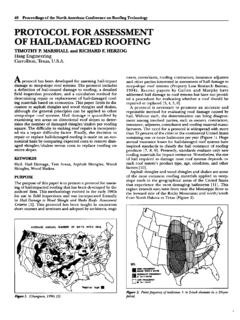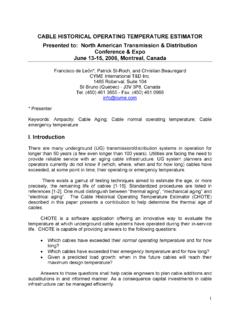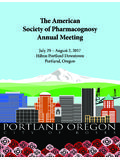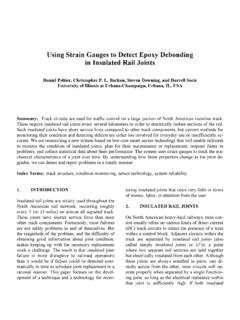Transcription of The North American Shortwave Association - …
1 1 The North American Shortwave Association2 THE NASWA RADIO COUNTRY LISTSCOPE - This list is designed for those who listen to Shortwave broadcast (SWBC) - A standard for NASWA Scoreboard rank-ings, awards and contests and for individual record - In the early days of radio, hobby listeners made little distinction between communications (utility) stations and those broadcasting programs (SWBC). The end of World War II is a convenient point to mark that separation of SW interests. Therefore, users of this list need consider only one date, September 1, 1945. There are no subsequent cut-off dates. Logging an SWBC station at a particu-lar location can be counted for that radio country regardless of the date of that logging, providing it is after September 1, - Initial radio country references in this list are to each area s current commonly-used name.
2 Next, in parentheses, are listed names which that radio country previously used, in historical se-quence, back to 1945. The NASWA Radio Country List is formatted in two parts. The first is the basic country list itself, arranged alphabetically, by continent, and includes space for checking off those radio countries heard and verified, or for other personal record keeping uses. The second part is the gazetteer, a listing of the same radio countries arranged alphabetically, worldwide. This is intended as a reference tool to facilitate the use of the basic list. It includes help-ful background data on geography, political history and status, station locations and continent in which a radio country is located. In both parts of the list, an asterisk after a radio country name indicates it has been silent on SWBC for a substantial period of time.
3 Additional data may be added to the gazetteer in future editions of this list to make it even more useful as a reference - The NASWA Radio Country List is unique. It considers the interests of the longtime listener who has heard and counted some radio countries which, in the political world, no longer exist. Even if war or revolution, conquest or annexation, split-up or merger, change the world map, the listener need not subtract these politically defunct countries from his or her tally. The interests of the person who began listening much more recently also are taken into consider-ation. That person can count loggings of stations in countries which, politically, are extinct. This seems fair to all. After all, reception of Shortwave stations is not directly linked to such matters as political boundaries or independence dates.
4 In determining a radio country, the six-member NASWA Country List Committee considers, insofar as possible, three factors: geography, politics and hobby tradition. Although in considering a particu-lar case these factors sometimes conflict, the com-mittee strives to reflect what it believes to be the mainstream of DXer opinion. This list includes radio countries which have, or have had, SWBC stations on the air at some time since the end of World War II. It is likely that no DXer has ever heard, much less verified, all of them. Many of these still are represented on the air, giving DXers a wide range of targets to tune. Additions to this list, and name changes, when appropriate, may be made from time to time by the committee. But for reasons noted above, there will be no deletions from the list due to a station ceas-ing to broadcast or because of geo-political factors.
5 Persons interested in a more detailed history and explanation of radio countries in general, and the philosophy involved in the creation of the NAS-WA list nearly 40 years ago, are referred to: Count-ing Countries, an article by Don Jensen, chairman, NASWA Country List Committee, in PROCEEDINGS 1989 (Fine Tuning Special Publications, Stillwater, OK), reprinted on several occasions in past issues of NASWA s THE JOURNAL. Questions and comments regarding this list and its use may be directed to the NASWA Country List Committee, c/o NASWA DATE MAY 1, 20163 NASWA STATION COUNTING RULES What is an SWBC station? The Country List Committee has prepared the following guidelines. Like the radio country list itself, these rules are a combination of logic, tradition and good judgment. In making its decisions, the committee attempts to apply reason and fairness, and recognizes generally accepted practices in the listening hobby.
6 1. An SWBC station is a station whose funda-mental frequency lies in the radio spectrum be-tween 2,000 and 30,000 kHz., whose broadcasts are intended for reception by the general public. This includes standard frequency and time stations with voice announcements, satellite stations in space which transmit intelligible material and utility sta-tions which periodically carry broadcast program-ming intended for direct reception by a general listening audience. SWBC stations may transmit in analog AM, digi-tal AM (DRM) or single sideband modes. This definition excludes spurious and harmonic radiation of broadcast signals whose fundamental frequency lies outside the radio spectrum range between 2,000 and 30,000 kHz, even though the frequency of the received spurious and/or harmonic signal lies within that range. Reception of har-monics of medium wave broadcast stations heard within the defined Shortwave frequency range are not considered SWBC stations.
7 The definition also excludes satellite stations in space which transmit only telemetry data and/or CW Morse signals. Also excluded are utility stations transmitting voice mirror repeated identifications; point-to-point relays and other utility type transmissions; aero, marine or public service stations carrying weather reports; ship-to-shore, military transmissions, etc. 2. Each transmitter site of a broadcasting orga-nization constitutes a separate and distinct station. Any move in transmitter site creates a new station to be counted. When a broadcast organization uses multiple transmitter sites, unless the organization is widely known to use a specific transmitter site on a specific frequency at a specific time, verifica-tion should show transmitter site before credit is claimed. Although many broadcast organizations operate several transmitters at a given site, the virtual impossibility of identifying the various trans-mitters rules out counting separate transmitters at that site as separate stations.
8 3. Different services of the same broadcast organization ( Radio Canada International and CBC North services) do not count as separate stations when using the same transmitter site at different times. 4. Different program sources when leasing airtime from a transmitter/station ( various government, exile or religious programs aired by Sentech or VT Merlin) do not count as separate sta-tions. 5. Transmissions of a single broadcast orga-nization on various frequencies may be counted only once. The use of multiple frequencies for a broadcast does not create as many new stations as frequencies used. 6. A change of station ownership through sale, independence of the country or revolution consti-tutes a new station when coupled with changes in call or slogan. 7. In the case of Monaco, where stations stu-dios are in Monaco but transmitters are in France, albeit a few miles away, Monaco will be considered the station location.
9 In the case of Vatican City, it should be noted that Italy recognizes Vatican sovereignty over transmitter sites outside Vatican City proper. Should similar situations arise in the future, the Committee will consider each on a case-by-case NASWA COUNTRY LIST COMMITTEE Jerry Berg Wendel Craighead John Fisher John Herkimer, Chairman James Ronda4 PRACTICAL TIPS FOR USING THENASWA RADIO COUNTRY LIST In general, the factor of paramount importance is the location of a station s transmitter, as long as the reception is after Sept. 1, 1945. In counting a radio country, political considerations are of much less importance. Here are some examples: 1. Logging a station at Lusaka, Zambia counts as ZAMBIA (Northern Rhodesia), regardless of when, after Sept. 1, 1945, you hear the station. 2. Logging a station at Mogadishu, Somali Democratic Republic, formerly Italian Somaliland, counts as SOMALI, DEM.
10 REP. - ITALIAN (Italian Somaliland), whether received prior to 1960, when politically it was still Italian Somaliland, or after 1960, when it became, politically, the Somali Demo-cratic Republic. A longtime listener can count this country on the basis of a logging made long ago, as can the DXer who heard Mogadishu in more recent years. 3. Logging a station at Enugu, Nigeria, counts as NIGERIA - BIAFRA regardless of when, after Sept. 1, 1945, you hear it. The veteran listener who heard Enugu many years ago, then heard it a second time while breakaway Biafra existed (1967-1970), and heard it a third time in more recent times, after the area was politically reincorporated into Nigeria, will have heard three separate stations (see Station Counting Rule #6) but only a single country. 4. Logging a station at Goa, now a part of India, but at one time, prior to 1961, a Portuguese possession, counts as INDIA - GOA (Portuguese Goa).






